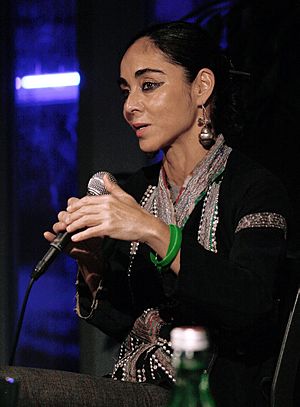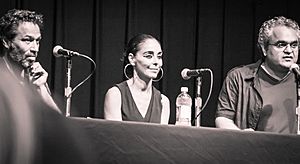Shirin Neshat facts for kids
Quick facts for kids
Shirin Neshat
|
|
|---|---|

Neshat at the Viennale 2009
|
|
| Born | March 26, 1957 Qazvin, Iran
|
| Nationality | Iranian-American |
| Education | University of California, Berkeley (BA, MA, MFA) |
| Known for | Mixed media performance, video installations, photography |
|
Notable work
|
The Shadow under the Web (1997), Speechless (1996), Women without Men (2004) Rapture (1999) |
| Movement | Contemporary art |
| Spouse(s) | Kyong Park (divorced) |
| Partner(s) | Shoja Azari |
| Awards | Silver Lion Venice Film Festival, Golden Lion Venice Biennale |
Shirin Neshat (born March 26, 1957) is an Iranian artist who lives in New York City. She is famous for her work in film, video, and photography. Her art often explores the differences between Eastern and Western cultures. She also looks at the differences between men and women, and public and private life.
Neshat grew up in Iran before the Iranian Revolution of 1979. After the revolution, the country changed a lot. She has said that these changes made her want to create art about serious topics like freedom and justice. She says her art is a "cry for humanity," even though she doesn't see herself as an activist.
Neshat has won many awards for her powerful work. In 1999, she won a major international award at the Venice Biennale, a famous art show. In 2009, she won the Silver Lion award for best director at the Venice Film Festival. The HuffPost news site even named her the "Artist of the Decade."
Contents
Early Life and Education
Shirin Neshat was born in the city of Qazvin, Iran. She was the fourth of five children in a well-off family. Her father was a doctor, and her mother was a homemaker. She grew up in a supportive Muslim family and learned traditional values from her grandparents.
Her father admired Western culture and wanted his children to have a good education. He encouraged his daughters to be independent, learn about the world, and take risks. He sent all his children to college.
In 1975, when she was 17, Neshat moved to the United States to study art. She went to the University of California, Berkeley, where she earned three degrees in art. After graduating in 1983, she moved to New York City. At first, she found the New York art world to be very competitive and stopped making art for about ten years.
In 1990, Neshat visited Iran again. She was shocked by how much the country had changed since she left. This experience inspired her to start creating art again. In 1993, she began making the photographs that would make her famous.
Artistic Works
Neshat's art explores the lives of women in modern Islamic societies. She uses her work to look at complex ideas about identity and religion. She doesn't give easy answers but instead asks viewers to think about these topics.
Photography
Her first famous works were photographs. In her series Women of Allah (1993–97), she took black-and-white photos of women. She then wrote beautiful Persian calligraphy (a style of handwriting) over the images. This series explored ideas about women and faith in her home country.
Films and Videos
Neshat is also a well-known filmmaker. She was inspired by the Iranian director Abbas Kiarostami. Many of her video works are shown on two screens at the same time. This creates a strong visual contrast, like black and white, or male and female.
Some of her famous video works include Turbulent (1998) and Rapture (1999). For Rapture, she worked with almost 250 extras to create a powerful and emotional piece. Her goal was to create an aesthetic and poetic experience for the viewer.
In 2009, she directed her first movie, Women Without Men. The film is based on a famous novel by an Iranian writer. It tells the story of four women during an important time in Iran's history. The movie was a great success and won her the Best Director award at the Venice Film Festival.
Music and Performances
Music is very important in Neshat's work. She often uses sound to create a strong emotional feeling. In 2001, she worked with singer Sussan Deyhim to create a live performance called Logic of the Birds. She believes that music helps connect her art with people from all cultures.
Exhibitions and Recognition
Neshat's art has been shown in museums and galleries all over the world. Her first solo show was in New York in 1993. Since then, major museums have held large exhibitions of her work, called retrospectives. In 2019, The Broad Museum in Los Angeles held the largest exhibition of her work to date, called Shirin Neshat: I Will Greet the Sun Again.
She has received many honors for her contributions to art. In 2006, she won The Dorothy and Lillian Gish Prize, a major award given to artists who have made the world more beautiful. In 2010, a critic for the Huffington Post called her the "Artist of the Decade." He said her art was important because it dealt with the biggest issues of our time, like culture, religion, and human rights.
Directing an Opera
In 2017, Neshat took on a new challenge: directing an opera. She directed Giuseppe Verdi's famous opera Aida at the Salzburg Festival in Austria. The opera is about a love story that is threatened by war and politics. Neshat said that she could relate to the main character, Aida, and that "sometimes the boundaries between Aida and myself are blurred."
List of Major Works
- Turbulent, 1998. Two-screen video and audio installation.
- Rapture, 1999. Two-screen video and audio installation.
- Soliloquy, 1999. Color video and audio installation.
- Fervor, 2000. Two-screen video and audio installation.
- Passage, 2001. Single-screen video and audio installation.
- Logic of the Birds, 2002. Multi-media performance.
- Tooba, 2002. Two-screen video and audio installation.
- The Last Word, 2003. Single-screen video and audio installation.
- Mahdokht, 2004. Three-screen video and audio installation.
- Zarin, 2005. Single-screen video and audio installation.
- Women Without Men, 2009. Feature film.
- Illusions & Mirrors, 2013. Short film featuring Natalie Portman.
- Looking for Oum Kulthum, 2017. Feature film.
- Land of Dreams, 2021. Feature film.
- The Fury, 2022. Two-screen video installation.
Awards
- First International Prize at the Venice Biennale (1999)
- Grand Prix at the Kwangju Biennale (2000)
- Visual Art Award from the Edinburgh International Film Festival (2000)
- Infinity Award from the International Center of Photography, New York (2002)
- Hiroshima Freedom Prize from the Hiroshima Museum of Art (2005)
- The Dorothy and Lillian Gish Prize, New York (2006)
- Silver Lion Award for Best Director, 66th Venice International Film Festival (2009)
- Crystal Award, World Economic Forum, Davos, Switzerland (2014)
- Praemium Imperiale Award (2017)
- Honorary Fellowship of the Royal Photographic Society, Bristol (2020)
See also
 In Spanish: Shirin Neshat para niños
In Spanish: Shirin Neshat para niños
- Iranian cinema
- Iranian modern and contemporary art


